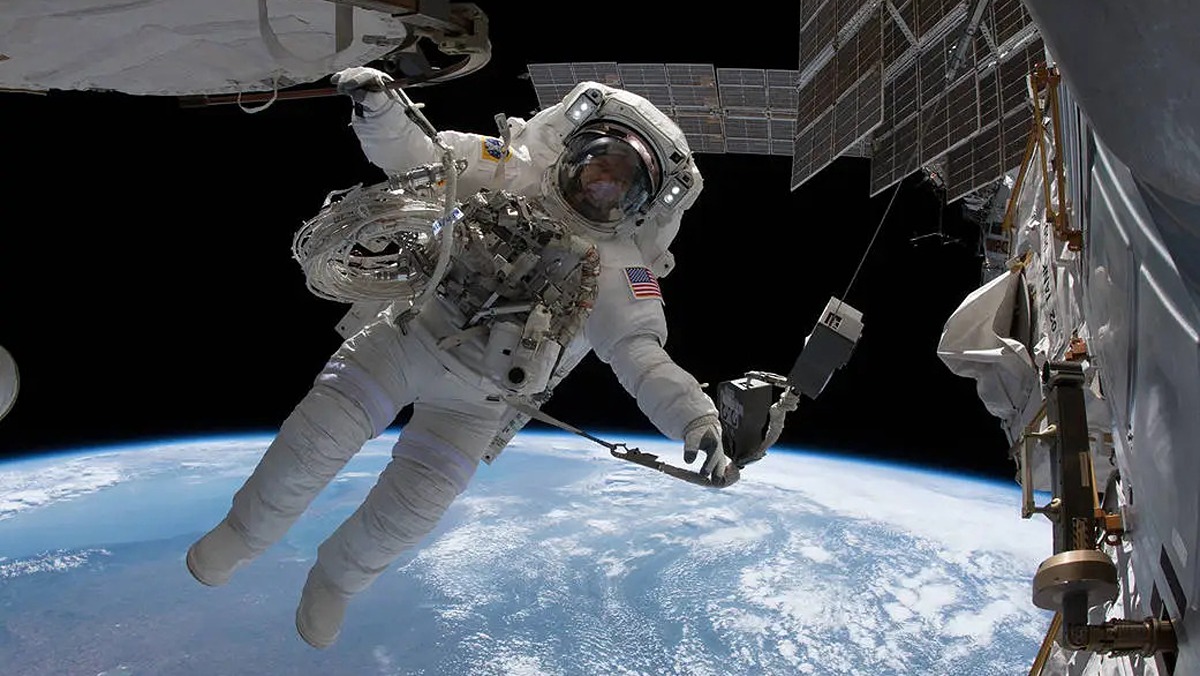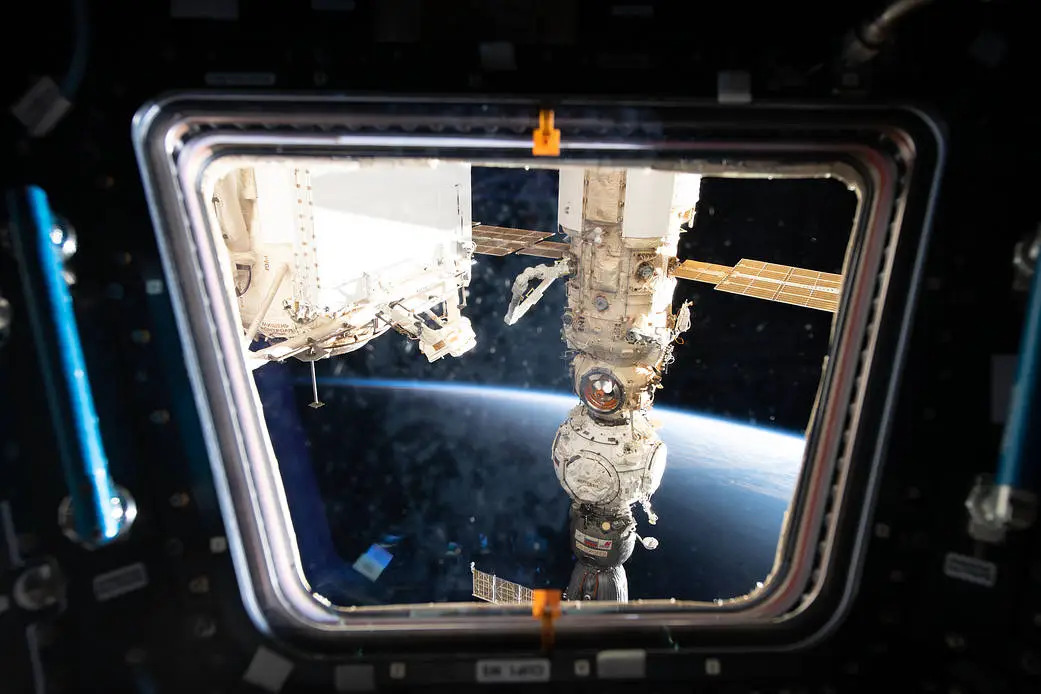NASA calls off spacewalk due to leak on International Space Station
The spacewalk, originally planned for Oct. 12, was for unrelated maintenance work on the space station.

NASA has canceled a spacewalk planned for Thursday (Oct. 12) following a space station leak detected earlier this week.
NASA officials called off the planned International Space Station (ISS) spacewalk on Wednesday (Oct. 11), as a precautionary measure after a leak of ammonia coolant was spotted Monday (Oct. 9) in a backup radiator on the Russian Nauka science module. Another spacewalk on Oct. 20 is also postponed and new dates will be announced shortly, NASA officials stated.
The two spacewalks are rescheduled for Oct. 19 and Oct. 30, respectively.
"NASA engineering and flight control teams are continuing to review data and video" from the leak, officials said in an update Wednesday, saying NASA will wait until the review is complete before authorizing the planned spacewalks.
"The leak has now ceased," they added, "as was reported by Roscosmos flight controllers and evidenced by NASA external station camera views, which show only residual coolant droplets."
Spacewalks taking place with floating ammonia flakes present often need extra steps to avoid contamination of equipment or astronauts. The cause of the leak remains under investigation.
Separately, the Russian space agency Roscosmos announced Tuesday via Telegram that it plans to task two cosmonauts with checking out the radiator during a previously planned spacewalk on Oct. 25.
Breaking space news, the latest updates on rocket launches, skywatching events and more!
Related: International Space Station leaks coolant into space, but astronauts are not in danger
Both Roscosmos and NASA officials have repeatedly said the leak — the third in Russian ISS equipment in the past year — had no material impact on space station operations.
But the delayed U.S. spacewalk will push off some minor maintenance on the station, along with a test that was supposed to be in support of future moon exploration.
The EVA originally scheduled for Thursday was supposed to see NASA astronaut Loral O'Hara and European Space Agency astronaut Andreas Mogensen, each on their first spacewalk, "exit the station's Quest airlock to collect samples for analysis to see whether microorganisms may exist on the exterior of the orbital complex," NASA officials wrote of the planned activities on Oct. 3.
A second activity, to replace a high-definition camera on the port truss of the station, was supposed to preview what could be possible with a planned lunar orbiting station called Gateway. Mogensen was tasked to ride aboard the robotic Canadarm2 to reach the camera, but with ground controllers directing the arm rather than the usual astronaut inside the ISS.
"Some of the tests of operations that we'll be doing as part of this EVA will help us inform the ops concepts for that future program," Elias Myrmo, U.S. spacewalk flight director, said during an Oct. 6 briefing livestreamed from NASA's Johnson Space Center in Houston.
Like the ISS, Gateway will also host a robotic arm made by the Canadian company MDA, called Canadarm3. The company also provides mission support for Canadarm2 on behalf of the Canadian Space Agency.
The delay also moved a milestone rare U.S. segment maintenance spacewalk set for later this month. It was planned on Oct. 20, with O'Hara on her second EVA, and NASA astronaut Jasmin Moghbeli undertaking her first. Should it go forward while the duo are on board ISS, it will be the fourth all-woman spacewalk, following the historic first such EVA in 2019 and two others performed by the same two astronauts.
Related: Spacewalks: How they work and major milestones
The Nauka coolant leak Monday was first reported by NASA's Mission Control from a camera view, and confirmed by Moghbeli with a visual check from the station's wraparound cupola windows. Nauka's backup radiator (the one that was leaking) is a 13-year-old device originally used on the Russian Rassvet module. Cosmonauts transferred that radiator to Nauka during an April 2023 spacewalk.
Nauka's coolant leak is the third in Russian ISS equipment in the past year, following a December 2022 leak in a Soyuz spacecraft built for astronauts, and a February 2023 leak in a Progress spacecraft designed for cargo. The Soyuz, called MS-22, was so damaged by the leak that Roscosmos elected to bring the three manifested astronauts home in a replacement Soyuz in September.
Addressing the Soyuz situation doubled that crew's planned six-month excursion to more than a year, marking an accidental milestone, as they were the first ISS crews to spend so long in space.
Roscosmos officials have said that the Soyuz and Progress coolant leaks were likely due to micrometeoroid strikes, but they note that the Nauka leak remains under investigation. The Oct. 25 spacewalk by cosmonauts Oleg Kononenko and Nikolai Chub was already planned; Russian state media TASS said in September, quoting Kononenko, that at least one more spacewalk was expected by the Russians in 2023, in October or November.
The new radiator inspection task will see the cosmonauts take photos and report their findings to Moscow, where their Mission Control is located, "for specialists on Earth to find out the reasons for its (the leak's) occurrence," Roscosmos stated on Telegram. Other tasks include installing a radar on Nauka for Earth observation, and launching a student nanosatellite designed to test solar sailing in space.
This story was updated Oct. 13 8:06 a.m. EDT with the newly announced dates for the spacewalks, and with an amendment concerning the all-woman spacewalk.

Elizabeth Howell (she/her), Ph.D., was a staff writer in the spaceflight channel between 2022 and 2024 specializing in Canadian space news. She was contributing writer for Space.com for 10 years from 2012 to 2024. Elizabeth's reporting includes multiple exclusives with the White House, leading world coverage about a lost-and-found space tomato on the International Space Station, witnessing five human spaceflight launches on two continents, flying parabolic, working inside a spacesuit, and participating in a simulated Mars mission. Her latest book, "Why Am I Taller?" (ECW Press, 2022) is co-written with astronaut Dave Williams.

